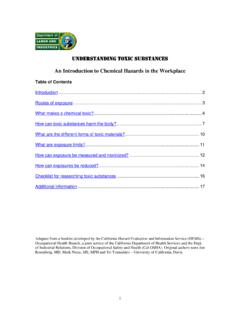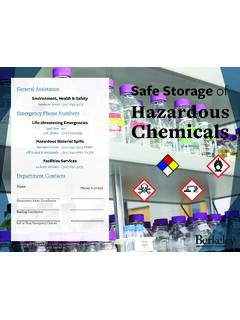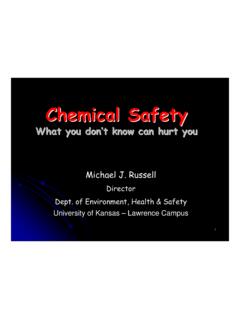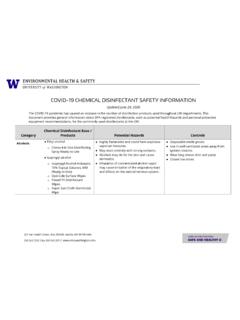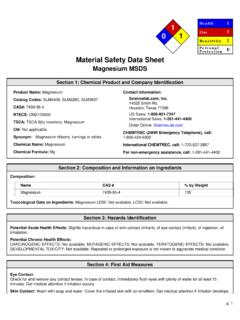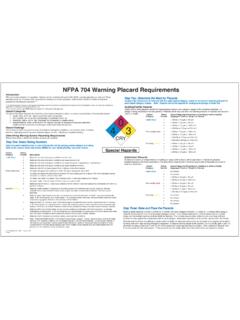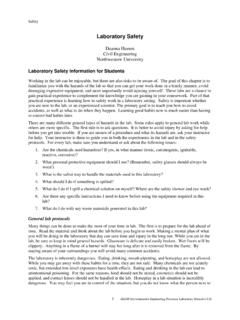Chemical Reaction Hazards And The
Found 9 free book(s)Introduction to Chemical Hazards in the Workplace
www.purdue.eduAn Introduction to Chemical Hazards in the Workplace Table of Contents ... reaction and interaction: other substances you are exposed to at the same time, and, ... chemical exceeds the rate at which you can eliminate it, some of the chemical will accumulate in your body. For example, if you work with a chemical for eight hours each
Understanding Chemical Hazard Labels and MSDS
miningquiz.comThe Yellow Section - Reactivity Hazards 4 The substance is readily capable of detonation or explosive reaction. 3 The substance may detonate when exposed to heat or an ignition source. 2 The substance is readily capable of non-explosive reaction. 1 The substance may become unstable at high temperatures. 0 The substance is stable. The White Section - Special Hazards
Environment, Health & Safety Hazardous
ehs.berkeley.educhemical families by an approved non-combustible partition or ... Hazards are rated from 0 for minimal hazard to 4 for severe hazard. The degree of hazard is often dependent upon the physical ... instability, potential for hazardous reaction with water, or Health.
Chemical Safety - University of Nebraska–Lincoln
ehs.unl.eduChemical Hazards- elements, chemical compounds, or mixtures of elements and/or compounds which poses potential risk to safety or health. 7 ... exposed people or animals to develop an allergic reaction in normal tissue after repeated exposure to the chemical. Title: Microsoft PowerPoint - mrussellUNLcolloqium2007.ppt
COVID-19 CHEMICAL DISINFECTANT SAFETY INFORMATION
www.ehs.washington.eduCOVID-19 CHEMICAL DISINFECTANT SAFETY INFORMATION Updated June 24 , 2020 . The COVID-19 pandemic has caused an increase in the number of disinfection products used throughout UW departments. This document provides general information about EPA-registered disinfectants, such as potential health hazards and personal protective
Mg Material Safety Data Sheet Chemical Name: Magnesium ...
dept.harpercollege.eduNov 01, 2010 · Violent chemical reaction with oxidizing agents. Reacts with water to create hydrogen gas and heat. Must be kept dry. Reacts with acids to form hydrogen gas which is highly flammable and explosive. Magnesium forms hazardous or explosive mixtures with aluminum and potassium perchlorate; ammonium nitrate; barium nitrate, barium dioxide and zinc ...
NFPA 704 Warning Placard Requirements
www.tdi.texas.gov2 Materials which will undergo a violent chemical change at elevated temperatures and pressures but do not detonate. A "W" should appear as a special hazard if contact with water may cause a violent reaction or may cause potentially explosive mixtures to be formed. Examples would include combustible metals and water reactive corrosive materials
Laboratory Safety - University of Washington
faculty.washington.edua chemical to a container, label it promptly. When you are finished with the experiment, dispose of the excess chemical as chemical waste. Do not simply pour the excess chemical down the sink. This is a bad habit that is potentially dangerous. The drains of the sinks should not become extra-curricular chemical experiments!
Chemical Safety Alert: Safe Storage and Handling of ...
www.epa.gov(amount) of water is added to a chemical, an unwanted reaction may occur, resulting in an increase in temperature and the release of toxic gas. Even a small amount of water splashed on the chemical may in some cases trigger a strong reaction. The main exception to this rule concerning water addition is when very large quantities of water
